October 26, 2009 - San Diego, California, USA
Interview by Bob Green, based on questions by Bob Green and
MrMike's posts to the MyPaipoBoards forum
Photos by Mike Shourds unless otherwise noted
1. How did you get started surfing?
When
I was about 10 year old we surfed on a 1/4 sheet of 3/8" ply that we
took out of my dad’s garage. Except for the slivers it did ok. We also
used to surf on cafeteria trays. What is a Hawaii Paipo Designs style
paipo but a super size cafeteria tray? I still have my tray from high
school in 1967.
I have been riding paipos since the summer of 1963, except we called
them bellyboards back then. My brother and I bought an old 60 pound
waterlogged 12' Hobie balsa board from a yard sale for $5.00. We tried
to surf it but got tired of it hitting us in the head so my brother
sold me his half for $5. I striped it down and made three 4 foot belly
boards. I sold one for $25 and kept the other. We surfed these crude
belly boards all summer.
What we wanted back then was a surf mat, but they cost $15.00. When we
tried one we did not like it. We could not get it outside on a 4 foot day.
I surfed Santa Anna river mouth on a 10 foot day with that board. I was
the only one to get out. That was the days before leashes. I was
hooked. I have been making them ever since.
2. Did you make many boards?
I
made a lot of paipos back in the 60s & early 70s when they came out
with foam boards that everybody wanted. Then after 30 more years nobody
knew what a paipo or belly board was. I have never changed over. I
still think the Hawaiians had it right the first time around. When I
sell a wood paipo I try to explain the history of the sport. It is kind
of a zen thing. Not trying to see how many waves you can snake from the
other guy, just being one with the water is all I need.
Most of my boards are sold to my friends at a discount rate for what it
cost me to make them. To me making them is just as much fun as surfing
them.
Mr.
Mike: "The board collection changes all the time because I sell some
and make new ones. I also make the covers and all are for sale."

3. Does this mean there are now lots of paipo riders in your area or are the boards treated as pieces of art/collectables?
I don't know what you call a lot but we can get 5 or 6 out on a good day.
4. Are they younger or older guys riding paipo in your area? Was there a time when paipo were popular – a heyday?
Most
of the people out now are older, the ones that still know how it used
to be. Paipos or bellyboards were never as popular as stand up surfing.
It was not cool but I never did go with the flow. I always thought
paipos were more fun and faster back then when paipos only weighed 5
pounds and surf boards weighed 50 pounds.
|
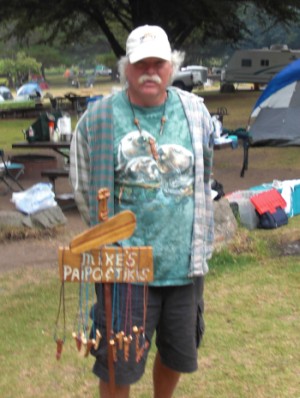
Mr. Mike and Paipo Tiki's, Big Sur Paipo Gathering, August 2009.
Photo by Rod Rodgers
This one is called "Small Fish"

|
5. So the boards are mostly sold locally?
I
also sell some on eBay. The best thing about making paipos is you can
see what works best. Since paipos don't have a set shape like
surfboards what work best is hard to say. With the big end at the nose
it work well on a slow mushy wave. You can get way over the nose and
get your legs up on the board and you can turn just by thinking about
it. With the big end at the tail it will work better on larger steep
fast wave. The large end bites into the wave but is harder to turn.
That is what has worked for me.
Oct 16, 2007. Here is a new board I just finished. It is basswood with lace wood and bubiga. Small and fast.
Dimensions: it is 36"x26"x5/8". Glass: Covered with 6oz "S" glass and 300 epoxy.

6. Do you mainly make wood or foam boards now?
Mostly
wood. I used to work in aircraft electronics. Then I retired. My dad
worked in wood and his dad. You can say it is in the blood. But I love
to surf them just as much. I have made boards with balsa, redwood, and
purple heart, monkey pod wood, zebra wood, white maple, paulownia and
basswood and also red cedar. Sometimes I am given wood, or I recycle old wood
that I find. Basswood is a little heavier, but stronger than balsa, and
nicer to work with. I like it but it costs about 20 percent more. Balsa wood
is real hard to find now and not a very green wood. Paulownia is a
better choice now. But most any wood will work.
I start by looking for wood that is flat and straight with good looking
grain. Sometimes this takes me about an hour or more. The lumber I start
with is 7/8" to 1" thick. I butt joint it all with Titebond II wood
glue -- I don't use Titebond III because it sets too fast because you need time to align the
wood. As for the noses I cut the wood with about two degree angle. When
it is glued it is kicked up about 1" to 2". As for the bottom I use my
power planer to get the shape I like. If I need more than the thickness
of the board I cut the boards with a small angle before gluing. This
will get you close to the shape you want. Use a straight edge or
framing square to check the bottom for symmetrical shape. I like my
boards on the thin side about 1/2" in the center 3/8" on the rails and
1/4" on the nose and tail. The rails are rolled down.
People ask me what I do with my scrap wood? I make tiki's out of the scrap. Waste not, want not.
7. Do you still make any foam boards?
When
I find broken surf boards. I don't like foam all that much. Too big of
a mess and toxic. Also, I am not the world’s best glasser. I like wood
better, but free is a good thing.
8. What are your thoughts on design?
As far as good design goes the sky’s the limit. Lots of good thinkers out there.
Short is better, turns faster, easy to get out in big surf, less to get
taken away from you in the crunch zone. I think 40" is maximum unless
you are really a big person, also less drag. Floating is not a factor.
Remember less is more when you are on your belly
A longer board is faster up to a point. With a longer board you also
have more drag so you got to see which is right for you. A bigger
person might want a 6 footer. A longer board is harder to turn and put
in the car. I weigh about 180 pounds and am 5'9" tall. A 5 footer works good
for me if I want a long board -- a 6 footer seems a little long because my legs
hit it when I kick out. I like the way they smoke down the line and
you can get almost your whole body on the board. The smaller tail is
less drag and make it a little easier to turn.
A little wider in the end makes for a smoother ride just like a woman,
but a narrow end I think makes it faster like a big gun surf board. I
ride my boards both ways with most of me on the board and with legs
off. Leg up equals faster, leg in water equals more turning power. I
don't think there is a board for every type of wave that is why I got
22 boards and still counting.
9. What about fins on the boards?
The
only use for fins is on your feet. On a paipo board fins just add drag
on the bottom. Well shaped rails will take the place of fins.
This one is called "Little Red." It is 40 inches long, 20
inches wide at the nose and 18 inches wide at the tail. The board is
made of red cedar with lots of knots (pain in the ass, but looks nice).
September 09, 2009.
Top View
|
Bottom View |
 |

|
| Mr.
Mike notes: "I don't like wax it get all over everything when it gets
hot. The pad is 1/16" thick and sticks you to the board real well. I
get it from www.northshoreinc.com. You can also get it in clear, but it is only 1/32" thick it is called clear traction grip |
10. How do you finish your wood boards?
I
have used Minwax Helmsman Spar Urethane Varnish, about 5 to 6 coats
with beeswax and orange oil over the urethane to make the bottom more
slick. With oil you got to redo it almost ever year. I now cover my
boards with light S glass 4 oz. and 300 epoxy. The epoxy is flexible
and won't shatter like other resin. It lasts forever. This epoxy is UV
resistant and won't yellow. It cures in 24 hours and is clear as glass.
Also, this epoxy has very low VOC (volatile organic compounds) and
cleans up with denatured alcohol. Even an old dog like me can learn new
tricks.
11. I‘ve seen photos of some of the different designs you have experimented with.
I
have been making paipo boards since 1962 and have tried almost
everything but
I still have lots to learn. I have been making boards now after a
design from the 1930s they seem to work well. Sometimes builders
overlook the past. But I have also tried lots of other designs. There
was a
paipo I made out of a skim board, an uppey downey board that was made
to be rode either way (16" at the big end and 12" at the small end and
50" long), concave bottoms, a ply spoon. Somebody help me I can't stop!
12. I believe you mostly surf around San Diego. When did you go to Hawaii?
Yes,
I have lived in Coronado for my whole life (60 years) and live 4 blocks from
the beach. I walk or ride my bike to the beach almost every day. I surf almost every day big or small the only days I don’t go out is after a storm with all the paipo in the water. Not
the best break in San Diego but it is in my back yard. I have been to
Hawaii three times. I like Kauai, lots of laid back action. I only surfed
on two beaches over there, Po‘ipu and some place over by the airport. I
got up early so I did not see another person. Some local told me that
was shark feeding time.
13. Did you see other paipo riders there?
No.
14. Any thoughts on the boards needed to ride bigger waves?
I
would have to make mine thicker or they would turn to tooth picks. I
like a shorter board in bigger waves, less to whack you with.
15. Any tips for someone wanting to try a paipo?
The
best way I have learnt, is to hold the board out in front of you and
when the wave starts to pick you up slip the board under you body and
you got to kick like a shark is chasing you. When you turn, drive the
inside rail down into the wave, right rail turn right, left rail turn
left. This will become second nature. Start small then work up. Paipos
boards work well on smaller waves also. With a neutral buoyancy board
it is like trying to water ski without a boat. You have got to get it
moving to make it work but when they get going they can be faster than
surfboards and your face is only one inch from the water. I have a Hawaii Paipo Designs
SR in my collection and I really like mine. I use it on larger days.
Wait till you try it on a large steep wave. It will blow you away it is
the fastest ride you will ever have. It doesn't have to float to go
fast.
16. How old are you now?
60.
17. Do you have a favorite board?
My
favorite is the one I take to the beach that day. I like the old but I
like all the new materials. So keep up forward thinking, that is why I
got 20 some boards. I can look at them and say I haven't rode that one
in awhile and find the fun in it again.
During the "The Great Big Honking Paipo Gathering"
in Big Sur, California, July 31 - August 4, 2009, everyone checked out
the wide range of paipos, some crafted from wood and ply... These are
some of Mr. Mike's.
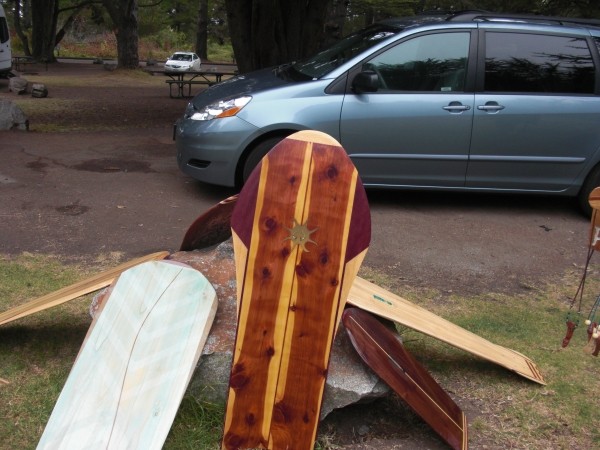
Photo by Rod Rodgers.
18. Any other comments?
I
am glad people are still making paipo the old way. All you need is a
piece of plywood and a wave to have a good time. You might want to wear
a swimsuit also.
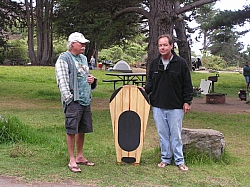
|
Different views and details of a board
sold by Mr. Mike during the
"The Great Big Honking Paipo Gathering."
(click on pic for a larger image)
Photos by Rod Rodgers
|
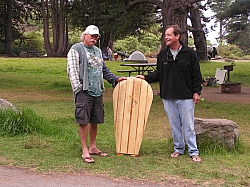
|
|
|
|
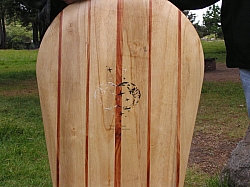
|
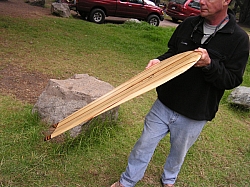
|
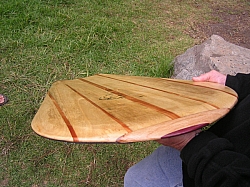
|
|
 |
 |
 |
|
|
|
 |
Mr. Mike at his local break catching some waves with his favorite paipo.
(click on pic for a larger image)
Photos courtesy of Mr. Mike |

|
|
You can contact Mr. Mike on the Paipo Forums to discuss board designs, construction techniques or buy a board or board bag.
Feel free to send me suggestions, comments and additional information to: The Paipo Interviews.
|
















